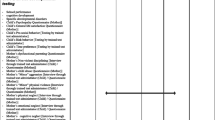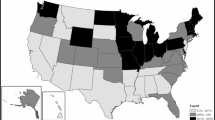Abstract
Objectives To determine whether participation in a home visiting program increases and expedites utilization of early intervention services for suspected developmental delays. Methods Children participating in Every Child Succeeds (ECS), a large home visiting (HV) program serving greater Cincinnati, between 2006 and 2012, were propensity score matched to a sample of children identified from birth records who did not receive services from ECS. Data were linked to early intervention (EI) data acquired from the Ohio Department of Health. Descriptive statistics were employed to evaluate success of the matching. Chi square and log-rank tests evaluated whether the proportion of children accessing EI and the time to EI services differed for families participating in HV compared to eligible children not participating. Logistic regression and Cox proportional hazards regression modeled the associations. Results Among 3574 HV and 3574 comparison participants, there was no difference in the time to EI service utilization; however a higher percentage of HV participants accessed services. Overall, 6% of the HV group and 4.3% of the comparison group accessed services (p = 0.001). Modeling revealed an odd ratio = 1.43 [95% confidence interval (CI) 1.16–1.78, p value = 0.001] and hazard ratio = 1.42 [95% CI 1.15–1.75, p value = 0.001]. Differences in utilization were greatest directly after birth and between approximately 2 and 3 years. Conclusions for Practise Participation in home visiting was associated with greater utilization of EI services during two important developmental time points, demonstrating that home visiting may serve as an important resource for facilitating access to early intervention services.


Similar content being viewed by others
References
3701-8-07 (2016). Help me grow early intervention system eligibility and determination of need for early intervention services. Retrieved July 20, 2016 from http://codes.ohio.gov/oac/3701-8-07.
Adirim, T., & Supplee, L. (2013). Overview of the federal home visiting program. Pediatrics, 132(Supplement 2), S59–S64.
Ammerman, R. T., Putnam, F. W., Kopke, J. E., Gannon, T. A., Short, J. A., Van Ginkel, J. B., et al. (2007). Development and implementation of a quality assurance infrastructure in a multisite home visitation program in Ohio and Kentucky. Journal of Prevention & Intervention in the Community, 34(1–2), 89–107.
Austin, P. C. (2011). Optimal caliper widths for propensity-score matching when estimating differences in means and differences in proportions in observational studies. Pharmaceutical Statistics, 10(2), 150–161.
Bagner, D. M., Frazier, S. L., & Berkovits, M. (2013). Getting ready for preschool: Linking early intervention and family mental health for infants and toddlers with developmental delay. Administration and Policy in Mental Health, 41(6), 707–711.
Barnett, W. S. (2011). Effectiveness of early educational intervention. Science, 333(6045), 975–978.
Daro, D. A., & Harding, K. A. Healthy Families America: Using research to enhance practice. The Future of Children, 1999, 152–176.
Feinberg, E., Silverstein, M., Donahue, S., & Bliss, R. (2011). The impact of race on participation in Part C early intervention services. Journal of Developmental and Behavioral Pediatrics: JDBP, 32(4), 284.
Goyal, N. K., Ammerman, R. T., Massie, J. A., Clark, M., & Van Ginkel, J. B. (2016). Using quality improvement to promote implementation and increase well child visits in home visiting. Child Abuse & Neglect, 53, 108–117.
Hall, E. S., Goyal, N. K., Ammerman, R. T., Miller, M. M., Jones, D. E., Short, J. A., et al. (2013). Development of a linked perinatal data resource from state administrative and community-based program data. Maternal and Child Health Journal, 18(1), 316–325.
Joining HANDS for a Comprehensive System of Care. (2012). Retrieved October 1, 2016 from http://www.pewcenteronthestates/homevisiting.
Olds, D. L., Hill, P. L., O’Brien, R., Racine, D., & Moritz, P. (2003). Taking preventive intervention to scale: The nurse-family partnership. Cognitive and Behavioral Practice, 10(4), 278–290.
Radecki, L., Sand-Loud, N., O’Connor, K. G., Sharp, S., & Olson, L. M. (2011). Trends in the use of standardized tools for developmental screening in early childhood: 2002–2009. Pediatrics, 128(1), 14–19.
Rosenberg, S. A., Robinson, C. C., Shaw, E. F., & Ellison, M. C. (2013). Part C early intervention for infants and toddlers: Percentage eligible versus served. Pediatrics, 131(1), 38–46.
Rosenberg, S. A., Zhang, D., & Robinson, C. C. (2008). Prevalence of developmental delays and participation in early intervention services for young children. Pediatrics, 121(6), e1503–e1509.
Sand, N., Silverstein, M., Glascoe, F. P., Gupta, V. B., Tonniges, T. P., & O’Connor, K. G. (2005). Pediatricians’ reported practices regarding developmental screening: Do guidelines work? Do they help? Pediatrics, 116(1), 174–179.
Scherzer, A. L., Chhagan, M., Kauchali, S., & Susser, E. (2012). Global perspective on early diagnosis and intervention for children with developmental delays and disabilities. Developmental Medicine and Child Neurology, 54(12), 1079–1084.
Shevell, M. (2008). Global developmental delay and mental retardation or intellectual disability: Conceptualization, evaluation, and etiology. Pediatric Clinics of North America, 55(5), 1071–1084.
Sices, L., Feudtner, C., McLaughlin, J., Drotar, D., & Williams, M. (2003). How do primary care physicians identify young children with developmental delays? A national survey. Journal of Developmental and Behavioral Pediatrics: JDBP, 24(6), 409–417.
Simon, A. E., Pastor, P. N., Avila, R. M., & Blumberg, S. J. (2013). Socioeconomic disadvantage and developmental delay among US children aged 18 months to 5 years. Journal of Epidemiology and Community Health, 67(8), 689–695.
Spittle, A. J., Orton, J., Doyle, L. W., & Boyd, R. (2007). Early developmental intervention programs post hospital discharge to prevent motor and cognitive impairments in preterm infants. The Cochrane Database of Systematic Reviews, 2007(2), CD005495.
Author information
Authors and Affiliations
Corresponding author
Rights and permissions
About this article
Cite this article
Bowers, K., Folger, A.T., Zhang, N. et al. Participation in Home Visitation is Associated with Higher Utilization of Early Intervention. Matern Child Health J 22, 494–500 (2018). https://doi.org/10.1007/s10995-017-2415-8
Published:
Issue Date:
DOI: https://doi.org/10.1007/s10995-017-2415-8




